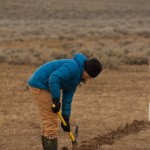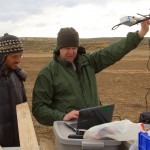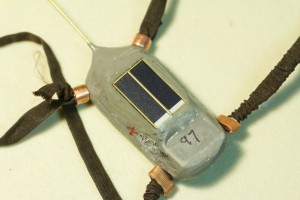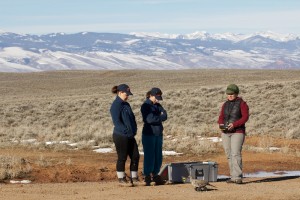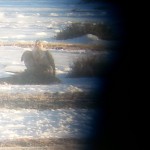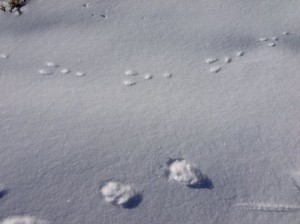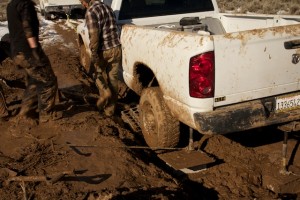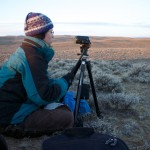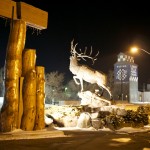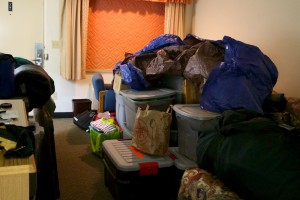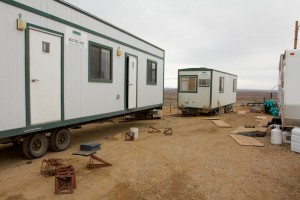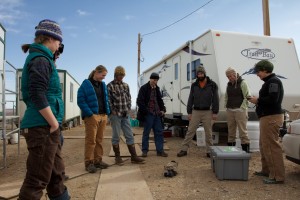 Last week our research appeared on the front page of the Nature Conservancy’s blog Cool Green Science. Nature Conservancy researcher Holly Copeland lives in Lander, and came out to watch a fembot experiment with Gail earlier in the month. I would be remiss in mentioning that Holly also invited our entire crew of 10 over to her house, and she and her husband Scott cooked us up an amazing meal of locally harvested game animals. A wonderful Wyoming experience!
Last week our research appeared on the front page of the Nature Conservancy’s blog Cool Green Science. Nature Conservancy researcher Holly Copeland lives in Lander, and came out to watch a fembot experiment with Gail earlier in the month. I would be remiss in mentioning that Holly also invited our entire crew of 10 over to her house, and she and her husband Scott cooked us up an amazing meal of locally harvested game animals. A wonderful Wyoming experience!
Tag Archives: field crew
Mid-Season Update (2014)
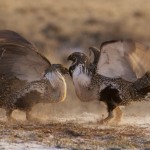 March has almost literally blown by out here in Windy Wyoming. It’s been a pretty good month so far, in spite of some cycles of mild snowfall and mud that have made our field work difficult at times.
March has almost literally blown by out here in Windy Wyoming. It’s been a pretty good month so far, in spite of some cycles of mild snowfall and mud that have made our field work difficult at times.
The breeding season started in earnest with a Cottontail Lek copulation on March 19th. This was tied for our earliest one on record. My impression is that the peak in breeding is fairly spread out this year, with female attendance and numbers of copulations not necessarily following the quick increase and decrease that marks some years. Maybe bad weather early in the season tends to synchronize the females more as the earliest hens delay breeding, but the lack of severe early storms or deep snow cover has spread things out this year? Just speculation.
Although it’s early in the season (and these data are only field observations and still pending new events collected from our video records), reproduction seems particularly skewed this year. The top guy on Cottontail seems especially strong. I’ll have a quick post about him soon. He’s now got our single-day record for copulations, and really dominates the lek in ways we’ve not seen in the past.
Study-wise, we’ve got pretty much everything going now. Microphone arrays have been deployed at our two leks (Cottontail and Chugwater), and we’ve collected two mornings of recordings on each lek. We’re getting used to the new cameras as well. There are good points and bad points (mostly good points I’d say). It’s really nice to be able to view the videos so quickly, and in our initial data collection from the tapes we realized you could even zoom in on certain areas of the screen! That is a pretty nice feature.
We did not put in a microphone array at Monument Lek, nor have we been monitoring it on a daily basis. Bird numbers there are about what they were last year, so we’re not going to invest as much in it since the males seem to have shifted their territories to places we can’t easily observe them. Sad to take a break from this lek- but hopefully it will rebound next year and we will be able to record behaviors and conduct experiment there again in the future.
Speaking of experiments, we actually got a complete set of early season fembot experiments in. More about this in a future post.
Our collaborator John Burt just left. John has been building the advanced telemetry tags we are deploying this year. We got a couple on last spring– these new ones have solar to help deal with the power needed to run both a GPS chip and an on-board accelerometer. We’ve got 13 tags in hand, and are looking forward to collecting data on where these males are getting their meals (and how that impacts their ability to put on a good show). We’ve already caught a dozen males, so hopefully it won’t take long to catch a few more and get all of these devices out on birds and collecting data.
We also enjoyed having Yale student Sam visit the camp for a few days. Sam is interested in the relationship between female preferences and male aggression, and thinks the sage-grouse might be an interesting system to look at this issue.
An exciting couple of days
An early visit from our collaborator Jen Forbey and a few other members of her lab should have been exciting enough for early March at our camp. Jen has been looking at the interactions between grouse and sage- basically how sage nutrition and chemical defenses affect grouse physiology and foraging behavior. Her visit was for some mutual training possibilities. Her graduate student Marcella has a lot of trapping experience, and was able to show us a new spotlighting technique that we’ve now adopted. It’s an “on foot” method, where birds are first seen from a truck driving on an established road, then a pair of people walk out to the bird, one with the spotlight and a portable speaker blaring music, and the other close on their heels with a net. We trained Marcella on our video and buttprint protocols, and also got her going with a recording unit to get some recordings from her Idaho population. The Boise team also completed sage-sampling at three leks to look at forage quality surrounding these display grounds. Jen and her crew were fun even when we were squeezing 13 people in to the trailer for dinner!
I mentioned some excitement. First was the once-a-decade (or more) visit of a large arctic falcon called a Gyrfalcon to Cottontail. Sean and James got some digiscope photos of a falcon that we initially assumed was Prairie Falcon, but further review of the images suggested it might be the larger Gyrfalcon. Not only did they see it, but they saw it make several passes over the lek before finally killing and eating a male sage-grouse! Sadly it was a male who was already a favorite- named Roundasaurus Leks due to his buttprint looking like the head of a T-Rex. We almost never see predation events on the lek, and to see one so early in the season, and by such an unexpected predator, was pretty mindblowing.
The gyrfalcon came back the next day and James and Sam were able to get some more diagnostic images from a zoomed in video. Unfortunately it hasn’t been back since then, and I haven’t gotten to see it yet. Maybe I shouldn’t say unfortunately, since this bird seems pretty capable of reducing our sample size in a rapid manner!
Jen and her technician Brecken dissected the unlucky male grouse to see what it had been eating (all sage, in spite of the presence of some forbs and insects during the warmer days). I’ll probably have more about that in a subsequent post.
Second: another wildlife sighting. Jen and Gail were at Monument Lek and noticed the burrow and tracks of Pygmy Rabbit! This is another sage-specialist that Jen studies, so she knew what to look for. In some places this is a threatened species. I’m not aware of it’s status in our neck of the woods, but neither Stan nor Sue our agency contacts were aware this species resided in the Hudson area so we will count this as a cool discovery.
Last was something exciting but not quite as fun. I tried to take the crew and Jen’s crew down to the Monument Rocks for a quick but fun excursion. There was still some snow on the road, but not enough to be a problem. Or so we thought. Maybe a half-mile past the lek, the snow covered up what turned out a treacherous mudhole. Trying to power through it only succeeded in me getting astoundingly high-centered. Day 1 we tried using the ATV to help pull it out, but the truck didn’t budge at all in spite of an hour or two of digging. Next morning, we tried another pick-up, but still no budging. It wasn’t until we’d deployed two jacks and dug almost completely under it, and then used the truck, that we finally got it out of there. Definitely not how we wanted to spend two days.
2014- Week 1
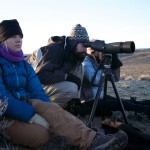 And 3 became 9- welcome James, Sam, Jess, Frank, Julia and Sean to Chicken Camp! The crew is here, and everyone saw grouse right away thanks to the active leks we have now. Part of the first few days involves the basics of grouse-watching: observing the courtship displays and aggressive interactions, getting used to the spotting scopes and so on. Anna also took the crew out this year to put survey stakes on the lek so we can map where the males are hanging out. I didn’t go this year, but you can see what this process looks like (hammers, long tape measurers, and usually lots and lots of mud).
And 3 became 9- welcome James, Sam, Jess, Frank, Julia and Sean to Chicken Camp! The crew is here, and everyone saw grouse right away thanks to the active leks we have now. Part of the first few days involves the basics of grouse-watching: observing the courtship displays and aggressive interactions, getting used to the spotting scopes and so on. Anna also took the crew out this year to put survey stakes on the lek so we can map where the males are hanging out. I didn’t go this year, but you can see what this process looks like (hammers, long tape measurers, and usually lots and lots of mud).
We’ve already had a couple of big changes from last year. First, for the first time since 2010, we won’t be doing individual ID work Monument Lek. Our initial counts showed about as many birds as at the end of last season (between 8 and 12 males), and again, most were hanging out in the sage and not on the main lek area. Unfortunately not enough that we can reliably target with the robot or coax inside our microphone array. Our plan at the moment is to only monitor 2 leks, Chugwater and Cottontail. Those haven’t shown much if any increase from last year, although we may still have some more guys show up.
The second big change is that we’ve started using our new video cameras. We tested 2 models of Sony (the PJ380 and PJ430) and one of Canon that I can’t remember at the moment. All seem superior to our (5-8 year old) Sony miniDV HD cameras, as well as the newer Canons we got at the end of last season. They are also almost comically small. Amazing what a few years of technology and no actual tape deck will do! We’ve ended up choosing the Sony because the user interface seems a little better and the quality seems a bit better too. The Sony PJ430 is a little more expensive, with a lot of bells and whistles we aren’t likely to need like GPS, but the image quality is noticeably better. Good enough that on Cottontail with it’s super-wide spread of birds, we can actually decrease the recording quality to save some storage space and still make out the birds better than we could on our old tape cameras. Progress!
2014 Season Start-up
March 4: It’s hard to believe that it’s already been a week since we loaded up the Durango and trusty Dodge pick-up (“Snowchief”) and headed out for Wyoming. A thousand miles, one-and-a-half books on tape, and one smoky hotel in rural Nevada, and we’ve exchanged the warm California winter for the icebox that is Lander. Although it had been about nine months since we last said goodbye to our second home in the sage, pulling into town always makes me feel like I’ve never left. From the friendly guy at RadioShack to the burgers and brew at the Lander Bar to the dips in the road as we leave the highway in Hudson, it really does feel like a time-warp has just removed everything that’s happened since we pulled up stakes last year. It is actually kind of eerie.
In spite of the familiarity of the place, field work is not exactly like Groundhog’s Day. Each year has it’s own set of challenges though. The first week was a bit of a “hurry up and wait” affair. We rushed to get the trailer out of storage in Riverton, only to find, when we de-winterized it, that the water heater wasn’t working. A night in the RV park with the heater running fixed that problem, and we got it up the hill the next day in hopes of get camp up and running quickly. Unfortunately, high winds east of us prevented the work trailer delivery from Casper on both Friday and Saturday. This has happened only once or twice before (last in 2011), and we actually asked some of the crew with flexibility to delay their arrival.
This had the added benefit of not having people driving during the snowstorm that hit on Saturday. We only got a few inches in Lander, but temperatures dropped to about zero. We more or less stayed in the hotel, staying out of the cold and catching up on computer tasks while we waited for the trailer delivery. With no good place to unload, or gear stayed in the hotel rooms as well. Finally one office trailer arrived on Monday gave us room to unpack the RV and make some living space. The second office trailer (yes, our first 3-trailer camp since 2008) came just in time for several assistants.
While we may not have been ready, the sage-grouse seem to be, at least a lot more than last year. With minimal snow on the ground and what seems like healthy sage for them to eat, we’ve already seen males and in some cases females on the lek.
By Tuesday we had the whole crew, and were able to welcome them to Chicken Camp 2014 edition! Welcome back Frank, and welcome Jess, Julia, James, Sam, and Sean!

